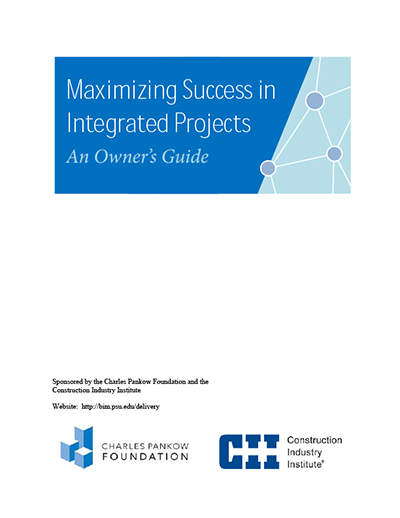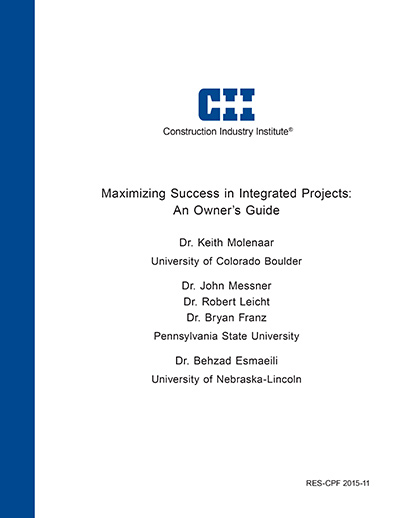
Maximizing Success in Integrated Projects: An Owner's Guide
Publication No
RES-CPF 2015-2
Type
Guidelines/Suggestions
Publication Date
Jan 01, 2016
Pages
54
Research Team
RES-CPF 2015
DOCUMENT DETAILS
Abstract
Key Findings
Filters & Tags
Abstract
This guide focuses on selecting an appropriate project delivery strategy to design and construct a facility that maximizes success for the owner. The guide describes a workshop approach to selecting a project delivery strategy and provides a template in Appendix A for running the workshop and documenting the outcome.
Key Findings
The use of the word integration has grown significantly in recent years, but the term is rarely defined. Integration is the combining or coordinating of separate elements into a harmonious, interrelated whole or unified system. In the context of the delivery process for a capital facility project, an integrated delivery process is the organizational coordination or combination of design and construction disciplines in support of the project goals. However, an integrated delivery process does not exclusively require a multiparty Integrated Project Delivery (IPD) contract. The evidence from this study finds that the majority of capital facility projects are delivered with conventional contract models (design-bid-build, construction manager at risk and design-build). Pursuing the spirit of integration can be undertaken to some degree in all delivery methods, but the success of implementing integrated practices is far more likely with certain project delivery strategies than others (RES-CPF 2015-2, p. 1).
A project delivery strategy is a high-level plan for structuring design and construction services. By selecting a project delivery strategy, an owner is making three critical project delivery decisions: (1) the organizational structure of the core project team; (2) the contract payment terms that define the methods of reimbursement for the work; and (3) the team assembly process. Additionally, our research finds that the owner has a role in developing an integrated team during the implementation phase of the project, both by encouraging participation in integrated practices and by building cohesion among team members. Team integration and team cohesion, which were found to be critical success factors in our empirical data, are often an implied, but rarely an explicit, consideration at the initiation of a capital project (RES-CPF 2015-2, p. 1). Descriptions of these decisions and success factors are listed below:
- Organizational structure: The organizational structure defines the hierarchy of the core project team, playing a critical role in establishing lines of communication, defining responsibilities and distributing those responsibilities amongst project team members.
- Contract payment terms: Significant portions of design and construction contracts are focused on payment provisions, or the method of reimbursement for the work. These terms define the invoicing requirements, the method of reimbursement (whether against explicit costs or a pre-defined schedule of values) and potentially a maximum agreed upon cost.
- Team assembly process: Team assembly practices, commonly referred to as procurement or acquisition, include the approach to soliciting proposals or bids, the methods for evaluating a potential primary builder or key trades and the criteria for selecting the core project team.
- Team integration: From an organizational perspective, team integration is the degree to which the core design and construction team members are brought together for a common purpose. A highly integrated team will leverage the expertise of individual team members to improve the value provided in the project delivery process.
- Team cohesion: The development of group cohesion is a tipping point, where newly formed groups transition into an effective team. Highly cohesive teams have compatible personalities, demonstrate strong commitment to project goals and can communicate efficiently.
From the 204 projects analyzed, three themes emerged for enabling the critical success factors of team integration and cohesion within the project team (RES-CPF 2015-2, p. 4):
- Early involvement of the core team – Early involvement, not only of the primary builder but also of critical design-build or design-assist specialty contractors, was essential to a successful delivery. Similarly, participation did not stop at the front end for the designers. Continuous interaction throughout the construction phase, including co-location and increased sharing of BIM, were found to maintain a high level of integration after design completion. Seventy-three percent (73%) of the top 40 schedule performing projects engaged the builder during schematic design or earlier, and fifty-five percent (55%) engaged specialty trades for critical systems before schematic design.
- Qualification-based selection of core team – When assembling the core project team, higher performing projects in this study did not select the primary builder and key specialty contractors based solely upon a bid or proposal price. Projects with the most cohesive teams focused more heavily on qualifications and used an interview process to assess the quality of the individual team members. Selection based solely on price was an indicator of the least integrated projects. This group of projects averaged four percent (4%) higher cost growth than projects where qualification-based criteria were used to select the core project team.
- Transparency in cost accounting – The use of open book accounting in contracts during the delivery process proved invaluable in the development of trust within the core project team. While most commonly found in the primary builder’s contract, this transparency was sometimes extended to key specialty trades. Projects using of closed-book payment terms averaged two percent (2%) higher cost growth. Closed-book projects led to less satisfied owners at project turnover. Additionally, contract terms that allowed for shared risk and reward, either through financial incentives or joint-management of responsibilities, were common in the delivery of successful projects.
This guide presents information to support a project delivery workshop held by the owner and key project stakeholders (RES-CPF 2015-2, p. 26). The objectives of the workshop are to:
- Provide a structured approach to selecting a project delivery strategy.
- Identify opportunities and obstacles for enhancing alignment in the core project team.
- Provide documentation of the decision process.
Filters & Tags
Knowledge Area
Project Phase
Project Function
Industry Group
Research Topic
Maximizing Success in Integrated Projects
Keywords
Building Information Modeling,
BIM,
BIM Project Execution Plan,
BIM uses,
BIM execution process,
BIM deliverables,
BIM Goals,
Information Exchanges,
BIM Infrastructure,
Project team implementation,
BIM implementation methods,
Process Maps,
3D model,
4D model


